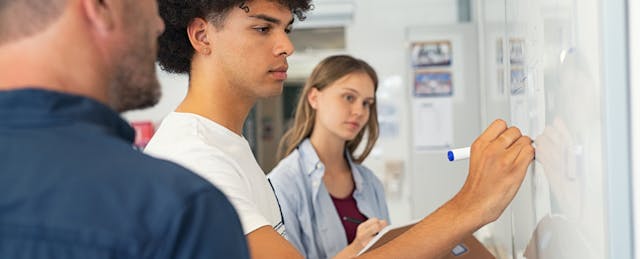A couple of years ago, Kelly Spoon decided to experiment with her assessment practices.
A number of instructors in the math department at San Diego Mesa College, where she's a professor, had started exploring how to weave standards-based grading — an approach that evaluates students on how effectively they have mastered content — into the way they teach calculus.
They sat down and figured out what knowledge students needed to grasp, and the extent to which they needed to prove proficiency. Not long after, Spoon started changing up how she handled quizzes in a calculus class she taught. Traditionally, Spoon says, grading practices for this course tend to emphasize student performance on a limited number of tests. Perhaps there’s a midterm, a final and a few other chances for students to prove what they’ve learned. The problem with this approach, she notes, is that if a student scores a 50 percent on an early exam, sometimes that doesn't feel recoverable and they put in less effort over the rest of the semester or drop the class.
She has changed her approach to grading in other classes as well, now offering more frequent assessments, providing chances to retake tests or quizzes and putting a stronger emphasis on incorporating accommodations in her class. For example, for a class that’s scheduled for two and a half hours, she makes sure her tests take only one hour. That way, students who need extra time don’t have to approach her to ask. Over time, she’s found that making these tweaks has encouraged her students to stick with the course if they have a bumpy start.
Spoon has found that the changes also allow her to hold students to a higher standard when it comes to explaining the math concepts, an approach that’s informed by pushes for more focus on critical thinking in classrooms. Because there are more chances to demonstrate what they’ve learned, she can push them to be more precise in the way they communicate about math.
Spoon's experiment coincided with research about how student performance is influenced by instructional practices.
Gateway courses such as statistics, algebra or precalculus serve as a portal to educational achievement and possible careers in science, technology, engineering and math. Students can get knocked off the pathway by poor performance in these courses, which has spurred interest in reform.
For Black and Latino students in gateway courses especially, instructional practices are often the most crucial determinant of whether they will succeed or fail, according to a new report.
A ‘Sense of Belonging’
While there’s been some qualitative research focused on the role of faculty and colleges on student success, there haven’t been many quantitative studies, according to Mina Dadgar, the founder of Education Equity Solutions, a college partner organization. Instead, she says, researchers have focused on other factors when it comes to post-secondary courses, like student preparation or demographics.
A study published in September by Dadgar’s organization explored the experiences of 22,827 students across four California community colleges between 2020 and 2022. The report added to the empirical evidence that math faculty’s grading and assessment practices are the most important factor affecting whether students passed or failed these courses.
The report also recommended instructional practices that its authors claim can reduce racial disparities in gateway math course outcomes, such as offering students more chances to improve, providing tailored feedback, ensuring that equitable accommodations are offered and fostering a sense of belonging for students.
There’s a perception among math faculty that gateway classes are becoming more challenging to teach, says Susan Bickerstaff, a senior research associate at the Community College Research Center. Some faculty report that the students taking these courses have more diverse prior math experiences, she says.
A decade ago, some of the students in these courses might not have found themselves in a college math course in the first place. But there’s been a lot of work done to make sure fewer students are being rerouted away from college math and diverted into prerequisite developmental courses, she says.
But the pool of students who have access to college-level math has broadened, Bickerstaff argues. So any challenges that come with this are good problems to have, she says, also noting that having a more diverse set of students in a given class increases the need to provide more support for high-quality teaching.
Lost In Translation
Some of the hurdles students face in math aren't directly about fathoming the material.
Student motivation, a sense of belonging and self-efficacy matter, Bickerstaff says. But you need to figure out how to support that in the math context, so it’s important to provide tools for faculty, she adds.
Part of that challenge, she says, is providing faculty with very specific examples that can guide their implementation of better instructional principles.
For instructors like Spoon, that means moving from research insight to classroom action. So far, Spoon reports that the changes are invigorating. Her students seem to be performing better already — though she’ll keep tinkering with possible improvements.
But the process of experimentation is not straightforward.
Like Spoon, Tammi Marshall, interim dean of math, science and engineering at Cuyamaca College, has also made some changes and now champions newer approaches to instruction and assessment.
But when she initially realized that her old tactics may have pushed some students away from careers they wanted, it was painful. She went through a period of mourning, she says. She meditated on the students in the past whose life-paths she believes she unintentionally thwarted.
When an instructor learns that they might have caused hardship, that can be a lot to take in: “It’s hard for me to hear that I caused harm,” Marshall says.
So, ultimately, these insights need to be expressed delicately to teachers, she argues.


